Via Romea Germanica IV
Bressanone, Italy to Chiusa.
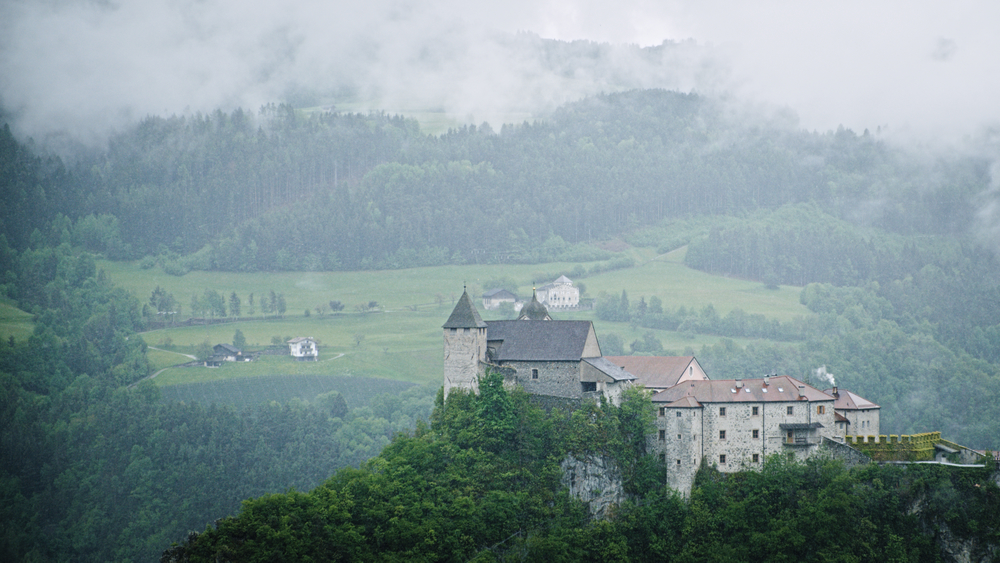
The Monasterio di Sabiona on a rain-soaked afternoon. Chiusa, Italy.
Rain.
More rain.
When the rain hits the ground, it produces mud. And more mud.
Thus we go, sliding down the mud-slicked mountains, hiking through the rain to Chiusa, Italy.
Welcome to the Peripatetic Historian's multi-part series about hiking the Via Romea Germanica.
If you have stumbled across this installment by accident or a fortuitous Google search, and have no idea what is happening, you might prefer to begin at the start of the series, here: Introduction to the Via Romea Germanica
Otherwise, let's return to our story, already in progress.
Yesterday evening (after I finished the day's post) Mary and I wandered down from our distant lodgings and strolled through the streets of Sunday evening Bressanone. The shops were closed. We poked our head into the Duomo, and then drifted through the piazza to the west of the cathedral. Our landlord for the evening had recommended a restaurant, but when we found it, we noted that it had a Michelin star and an upscale clientele. Feeling poor and under-dressed in our hiking gear, we chose to keep looking.
The few people haunting the Bressanone evening appeared to be making for a nearby pizzeria. When in doubt, act like a sheep and follow the herd. It was a good choice. The place was packed, and we were told that we would have a thirty minute wait for our pizzas. The reason, according to our waitress, was that everyone - both locals and tourists - knew that this was the best pizzeria in town.
We were seated at a table near the kitchen. Most diners will claim that a kitchen-side table is less than optimal, but we had the best seat in the house for watching the construction of the pizzas. Two young men divided the workload. One concentrated on producing crusts. He formed three dough balls at a time, packing them in a mountain of loose flour. Then he stretched each base, pulling it over the edge of a polished granite countertop until it was as thin as an old phonograph record. Once he had stretched ten bases, he and his assistant would ladle on the sauces, arrange the toppings, and slide them into the large wood-fired oven.
"Friday night," said our waitress, "We were open from 6:00 to 11:00, and they made 256 pizzas. They are great men."
Great indeed. According to my empty stomach, they were downright heroic. As were the pizzas, which were large, exquisitely thin, and unbelievably tasty.We ate to satiation and then, our stomachs stretched with pizza goodness, staggered back up the hill before the rain returned.
In the morning, we woke to an altered weather forecast. The monsoon - predicted to be the worst of the trip - was delayed. It wouldn't arrive until late-afternoon. Perhaps the day would pass without a soaking.
Oh, optimistic youth.
The weather boffins were wrong. It rained from the moment we stepped out of our Bressanone door, and was still going strong as we stumbled into Chiusa. Sometimes a slow drizzle, sometimes a pelting downpour, but there was never a moment during the entire day without rain.
The Via makes a steep ascent to the west as it leaves Bressanone. The road turned to a dirt path that continued up through a pine forest and past several votive chapels. This is Il sentiero dei Santi d'Europa (The Trail of the European Saints). Eight small chapels illustrate themes like "evangelization," "justice and peace," and "the family." Each chapel honors three European saints, and features a biblical verse rendered in three different European languages.
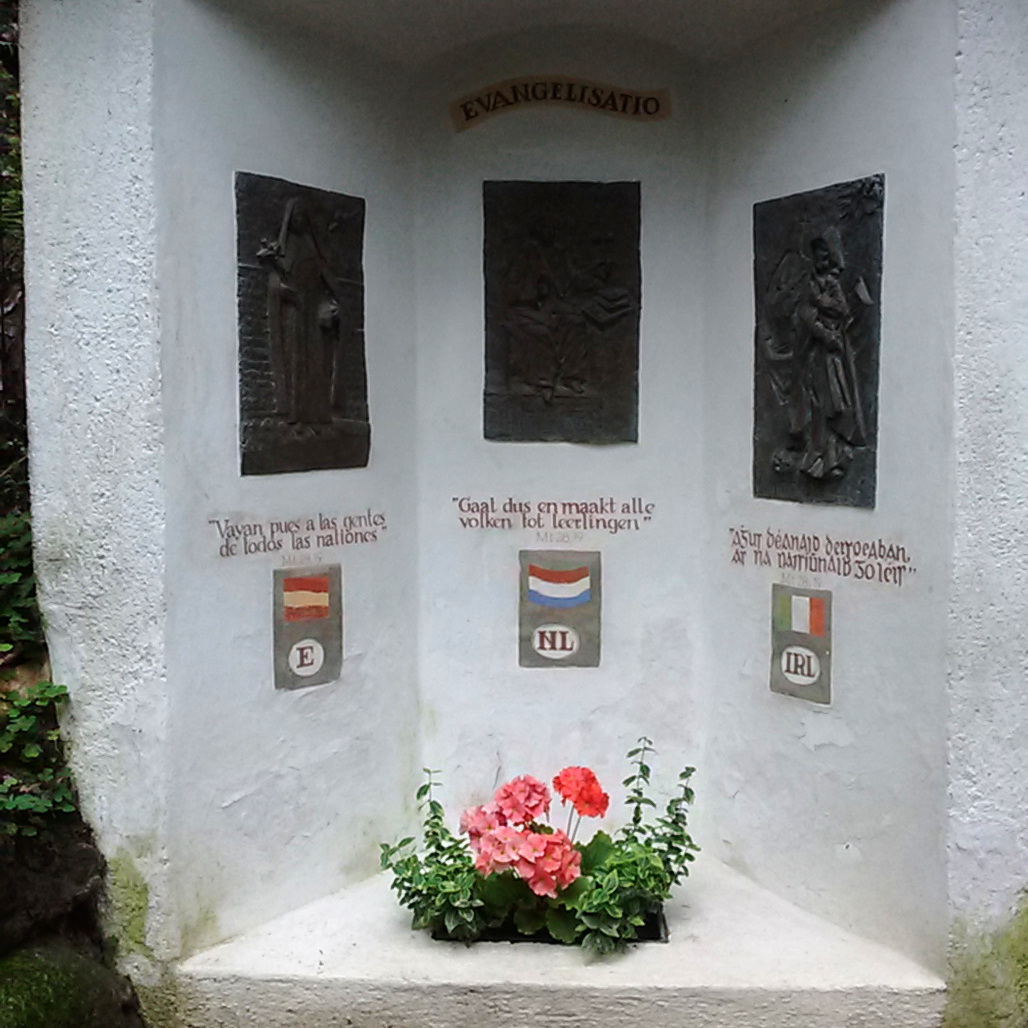
A chapel on the Trail of European Saints.
The Trail of the European Saints is designed to stimulate meditation on the virtues of the saints, and the pan-European gathering of saints should promote unity among the countries.
At the top of the trail, we discovered a church dedicated to Cyril of Alexandria, a fifth century bishop who was active in the Christological controversies of his time. He is an odd saint to find hanging out in the Italian Alps. The church is old, mentioned in documents that date to the thirteenth century. A fourteenth century fresco is painted on one wall, depicting the Virgin Mary with a sword piercing her heart. According to the church signboards, this is the first known representation of this iconography.
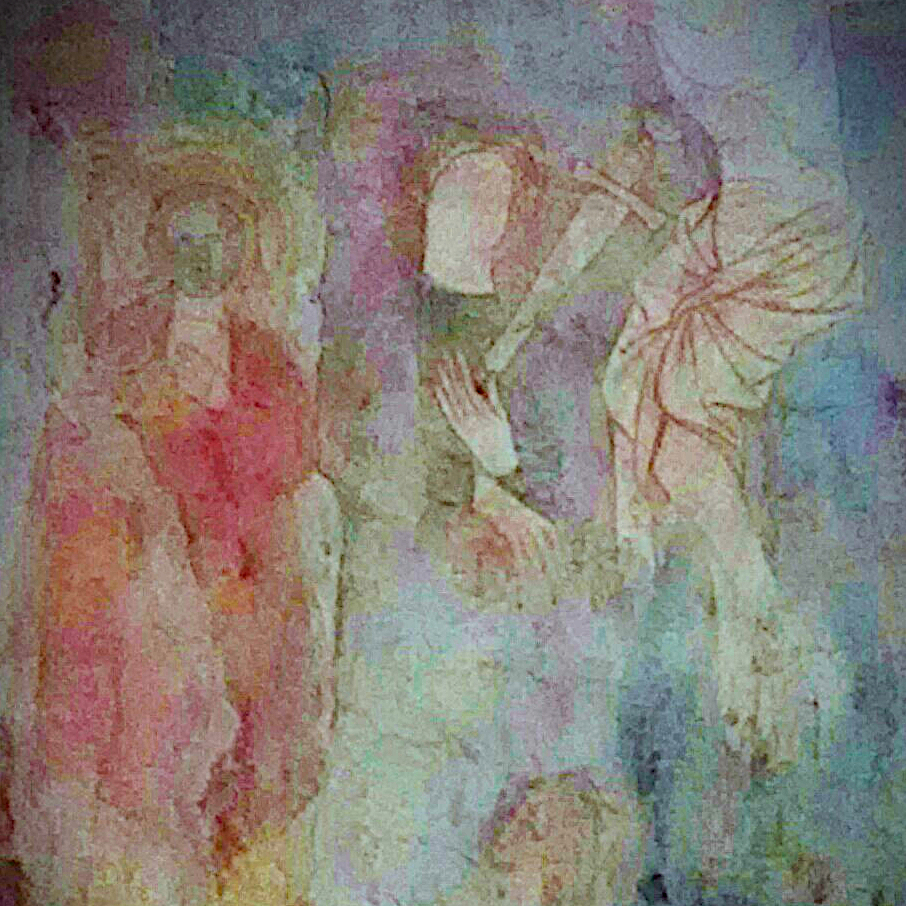
Early fresco of the Virgin Mary, St. Cyril's Church.
This rain-soaked day was also the first time we have encountered other hikers. We met a German couple outside the church who were hiking from Bressanone to Milano. I imagine the woods will become more crowded as the summer progresses, but we have felt quite alone for our first four days on the Via.
We followed the sentiero del castagno (the Chestnut Trail) south. The rain continued to fall. Low spots in road filled with water and puddles formed. With the relentless precipitation, I found that I was not taking very many photos. I snapped some grab shots with the phone, but I was reluctant to expose my expensive camera to the liquid onslaught.
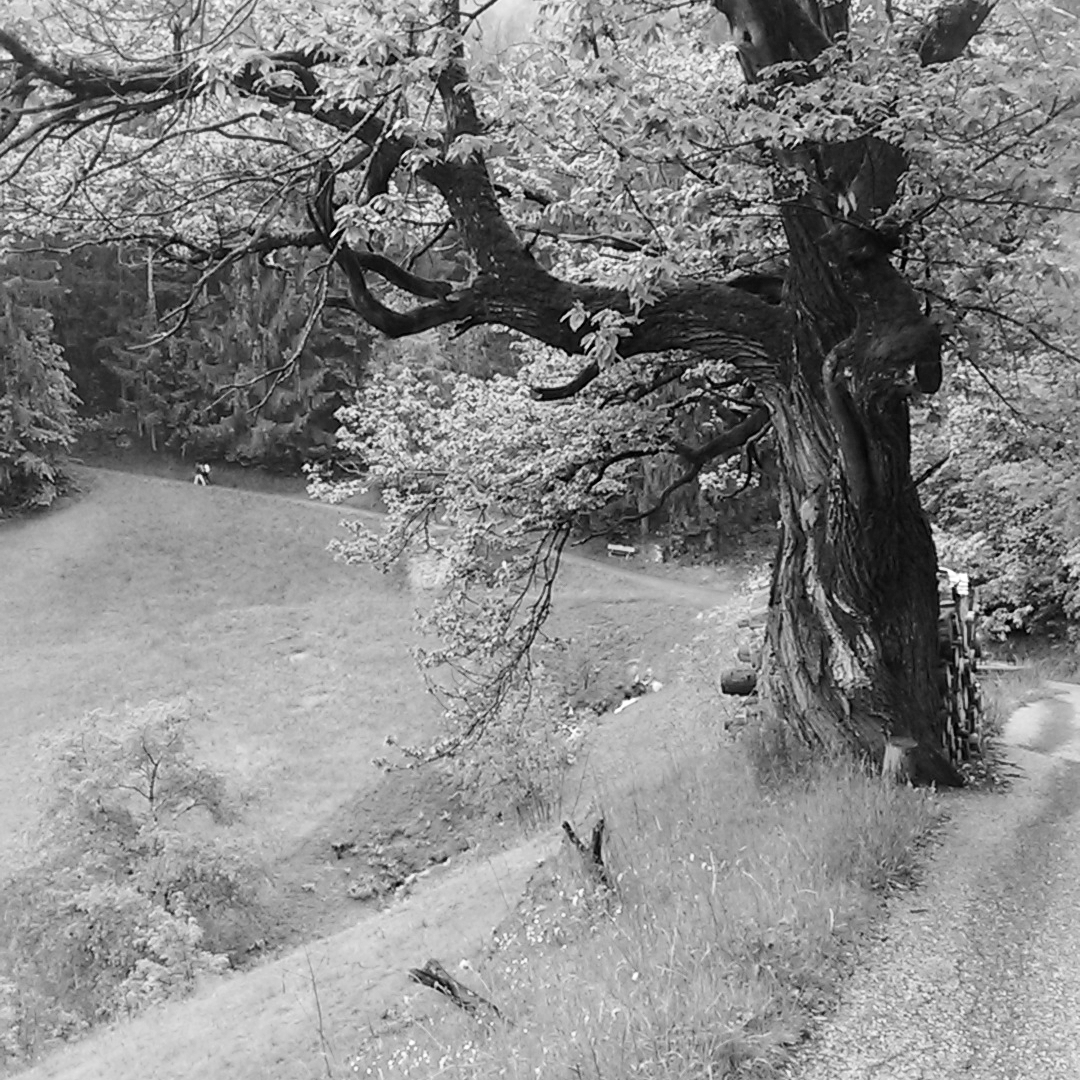
Following the Chestnut Trail.
It is unfortunate, for this stage of the Via would be magnificent on a sunny day, especially if you could see the mountains across the valley. We are still waiting for our chance. The clouds have kept the high peaks hidden.
We were completely soaked by the time we reached Velturno. My shirt and trousers were like sponges and whenever I leaned forward, a cascade of water would slosh out of the crease between my shoulders and my backpack cover. Although Velturno would undoubtedly reward further investigation, the inclement conditions had turned our minds to reaching Chiusa, and a hotel room out of the weather.
The rain made the downhill descent rather treacherous. The tree roots that weave a seine over portions of the path were slick, as was some of the shale and the smooth, weather-polished stone. Slippery mud further compounded our travail. We stumped slowly downward into the valley.
The trail worked its way around the base of the hill upon which the Monasterio di Sabiona sits. On a fine day we probably would have climbed up the hill to the monastery, but we had grown weary beneath the rain. Another opportunity lost, but it was certainly an impressive sight.
Ultimately we made a careful descent on the slippery stones lining the approach to the monastery and stepped gingerly into Chiusa.
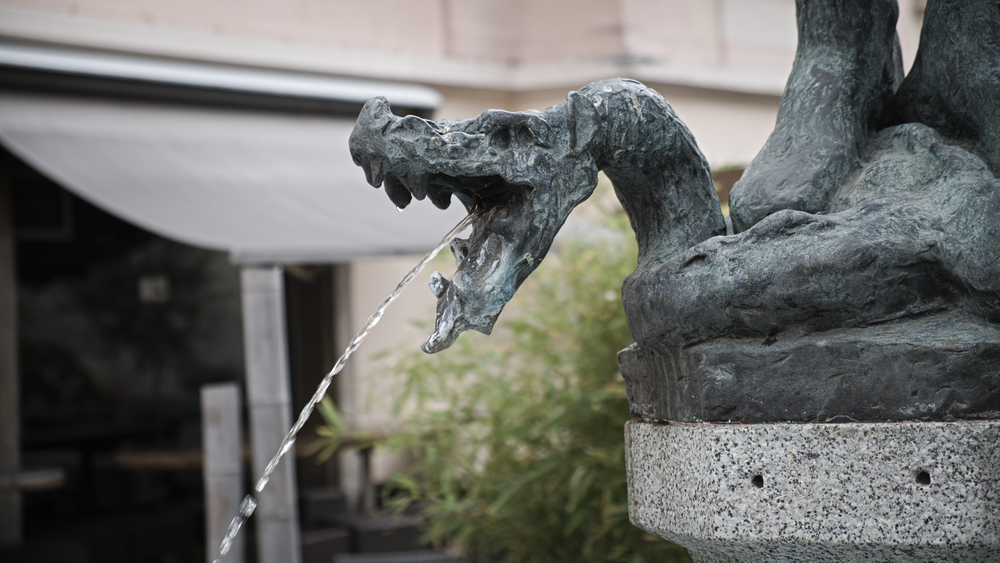
Rain fell like water from a snake's mouth.
Upon reaching our hotel, we unloaded our backpacks and draped our wet gear on the steam radiators. The room quickly filled with the smell of drying clothing, a homey, slightly-rancid, scent.
Italian restaurants are usually closed on Monday nights, but we were fortunate enough to find a delightful brewery near our hotel (less than a thirty second scamper through the rain) that was open and serving food. The brewery, in addition to making its own beer, specialized in artisanal/ecologically-friendly fare. I was drawn to an entree with the delightful name "stinco di maiale." Maiale is pig or boar, and stinco, despite its negative English association, is actually "shin" or "knuckle." It turned out to be a substantial piece of meat, accompanied by roast potatoes and sauerkraut.
The stinco was partially covered with a piece of roasted pork skin. It took me a surprising amount of time and effort to slice through this fleshy carapace. That should have been a warning. I popped a severed slab into my mouth and began to chew.
I chewed and chewed and chewed.
I took a sip of wine. I chewed some more. This was followed by more chewing. Well, you get the idea. I finally wore it down to a point where I could swallow without someone standing by to employ the Heimlich maneuver on me. Relentless. A good jaw workout.
The rest of the pork, however, was falling-off-the-bone tender. I sliced off chunks and ferried them to my happy mouth. I also enjoyed the sauerkraut. And, as a bit of a sidebar, the Austrians (and evidently the good folk of the Sud Tirol) really know how to make sauerkraut. I don't know what their secret is, but it almost melts on your tongue. It is smooth, soft, and creamy. There is no bitterness or graininess. It is a masterpiece. Feeling well-stuffed, we dashed back to our room (though the rain) and tucked in for the night.
The dominant story for today was rain, which clapped a stopper on sightseeing and photography. The temperature was perfect for hiking, but the precipitation washed away much of the enjoyment.
Unfortunately, the weather forecast for tomorrow offers little hope of respite. More rain scheduled for a much longer stage.
Today's distance: 17 KM; Total distance: 75 KM
If you are enjoying this series, why not subscribe to Richard's monthly newsletter, What's New in Old News? The Peripatetic Historian is on the road, roaming the world and compiling fresh adventures. Don't miss out. Click here to join the legions of above-average readers who have already subscribed.